My experiences of canoeing in the interior of Algonquin began like those of many other folks – as a young boy of 10 or 12 years with the unquestioned guidance of my father. We had done a couple father/son trips with groups of three other pairs where the dads did all of the planning, most of the packing and any serious decision making. The boys were along to enjoy the ride, provide some meager manpower and experience some of the simple joys and discoveries that Algonquin’s remote interior offers. Since reaching adulthood I have aspired to introduce those around me in a similar way – to do more than my share of the planning and heavy lifting while providing the beautiful venue for them to experience and enjoy. To date, I have now introduced eleven different people to the interior of Algonquin including my son, daughter and wife. The latest foray involved several new “chapters” to be opened. This included exploring a part of the park I have never visited through the Brent Access, a month of year (September) in which I have yearned to visit the park, and a tripping partner that I have never enjoyed the park alone with .. my lovely wife, Becky. Day 1 Our journey began on Saturday the 28th of September with the long drive north from Pennsylvania. We rushed to reach Algonquin Bound outfitters by 5pm in order to pick up our rental canoe for the following day's departure and made it in the nick of time. I extend a hearty “thank you” to Gord and the folks at Algonquin Bound for their terrific service. We have never been anything less than happy with the quality of the gear and overjoyed with the great, personal touch that they put on each rental exchange. Gord is a welcoming wealth of information and treats you like family from the first introduction. After we secured the ultralight Kevlar canoe to the car, we headed into Petawawa to grab dinner before heading north for a night’s stay. My wife pulled out her phone and did a quick check of the Urban Spoon app and found a “hit” of a restaurant called Medameek. It had great reviews and, luckily, was literally 100 meters away from the intersection we were at. Our expectations were somewhat low but we couldn’t have been more wrong! While it wasn’t a fine dining restaurant in terms of the décor and layout (counter service with take-out and a few small tables), it was one of the finest “Lebanese comfort food” meals I have ever enjoyed. Before we were finished with our meal I was scheming about how to arrange a second visit on our way back out of the park in six days! To top off the spectacular food, the existence of this establishment is dedicated to the memory of a lost hero of the Canadian military. It tickles the palate, warms the heart and fills the belly in one fell swoop! After a satisfying meal we headed a few kilometers north and spent the night at the Bear’s Den Lounge and Motel where we had a nightcap and put the finishing touches on the packs and material for tomorrow. Day 2 We awoke well rested and found that the heavy rains from the night before had slowed to a drizzle. But, the wind was forecast to pick up substantially out of the northwest. The forecast included several days of full sun and very light winds so we hoped for a light at the end of a very short tunnel. We had a bite to eat for breakfast and got on the road without wasting much time, to try to get across Cedar Lake before the wind got too strong. We arrived at the Brent permit office a few minutes after they opened at 9am and took care of the permit paperwork as well as getting an update on bear activity. Becky has a deep fear of bears that no amount of reason or statistical logic can dissuade. Gord had given her a bear bell and the folks at the permit office assured her that the chance of an encounter was exceedingly low. This didn’t alleviate her concerns a bit. 20 minutes later we were stopped at the viewing platform for the Brent Crater for a brief vista. The wooden steps and platform had a thin layer of ice on them and revealed a damp, foggy view of the remnants of a tremendous impact from eons ago. Within a few minutes the chill was creeping in so we got on our way to Cedar Lake with a brief stop in downtown Brent to visit the store and purchase a wonderful pair of simple gray wool gloves. I love wool – it holds up well to wear and works well when wet. Years of traveling in Algonquin have taught me that staying warm and dry is quite important in the shoulder seasons. Within 15 minutes we had the canoe loaded at the dock on Cedar Lake and were ready to start our highly anticipated journey. The water behind us was deceivingly smooth but I knew the small bay was in the lee of the wind. We were both smiling broadly with excitement and nervousness of what awaited us beyond the shores … The crossing of Cedar Lake was just as expected. Once we cleared the peninsula, the lake provided a perfect three or four kilometer fetch for the waves to build in front of the steady wind. I would estimate the wind speed to be between 20 and 25 Km/hr and there was virtually nothing to slow it down. Our Kevlar canoe handled it well with its buoyant nature, while the hull design provided excellent secondary stability. Becky was quickly turned off to the lack of initial stability and was quite certain we would be permanent residents of the black depths of the lake before we ever made landfall. She was virtually frozen with fear and found herself unable to paddle or even communicate during the 20 minute crossing through the choppiest rollers. When we finally made landfall at the first portage up the Petawawa River she commenced to swearing like a sailor at me. It was made clear that if similar conditions were to greet us upon our exit we would not be crossing Cedar Lake again. I assured her that we were in very little danger but, more importantly, that we would not have any more big water like that to cross in the days ahead. The sour taste that Cedar Lake left in her mouth slowly ebbed away as the heavy clouds appeared to be thinning. Our objective for the first night was Catfish Lake and I knew that the five portages (and particularly the “unicorn hill” slog) and the paddling between would take us the better part of the day to negotiate together at a steady pace. We stopped along the first portage to see the falls and the remnants of the old log dam/chute at the top. It was quite a spectacle to consider what this would have been like during high spring flows after a snow melt. The contrast of the park in different seasons entered my mind often during our journey but particularly here where our footsteps were certainly falling where many before us had trodden under much more difficult conditions. In short order we made it through to the longest portage of the trip and one with the greatest elevation change as well – the 2345 meter with nearly a 60 meter elevation gain by the halfway point. We attempted to single carry but as we hit the incline of the steepest section I was forced to drop my heavy pack and only take the canoe to the top of the hill. My burden looks enormous in the photo but the black front pack holds only a couple sleeping pads and a lunch sack so it was exceptionally light and just bulky. Between the canoe and two packs I was probably toting about 40 Kg – heavier than I would prefer but a sacrifice I would gladly make to lessen the load that Becky would have to shoulder. Once we hit Narrowbag Lake, the skies really began to lighten and we even got to see some peeks of blue from time to time. This was enough to bring smiles to our faces but the day's weather proved fickle and we would endure brief damp showers throughout the day right up until sunset. We weren’t quite to “peak” foliage but we enjoyed some wonderful splashes of color … We stopped and shared a snack of peanut butter and honey on multi-grain rolls for lunch along the shore of Narrowbag Lake to help rejuvenate our bodies and spirits after the “unicorn intervention” we'd gone through. This was the first time we brought this type of hard roll as our grain and the first experience was primo! The texture and flavor were great and they proved to be the most effective and enjoyable “bread” that I have yet found. They kept intact throughout the trip, did not mold and held up very well to the pounding and squishing that all packed objects must endure. These will be included in all foreseeable trips in the future! Once on Catfish Lake, we found the first site we stopped at among the group of 4 in the narrows was grossly mistreated by previous visitors. As we landed the canoe, a gentleman from a neighboring site gave a yell that there was a good bit of garbage on the site but we would find the next site to their south open and free of such debris. Normally I would pack such found garbage out with us but we were unable to take such a massive amount this early in our trip. It is always disappointing to see such disregard for nature’s beauty. The photo I took shows a full garbage bag but the fire pit was also chock full of plastic bottles and a variety of other junk. We ended up on the southern most site of the bunch at the first narrows of Catfish Lake. It offered a pretty view of the sunset. Day 3 The following morning brought a bit of a surprise. Instead of a calm and sunny morning, we were greeted with clouds and wind! I voiced my displeasure, in absentia, with the snafu the meteorological menace had delivered to us just to satisfy my own angst on the matter and I mentally prepared myself for many days of cloudy, windy and rainy weather. In this way I would not be disappointed again! At the very least, this breeze would offer a tail wind which, for anyone who has spent time in a canoe in Algonquin will tell you, is a true blessing! Within the hour we were breaking camp and packing the canoe. It became obvious that the sun would soon burn through the clouds and a vivid blue sky would shortly grace us. As it turned out, these were essentially the last clouds we would see for the remainder of our journey. Our first objective for the day, unfortunately, was to backtrack and try to locate my sunglasses. I had mindlessly set them down either at the end of the portage from Narrowbag or on the garbage strewn site. I was thinking it was the portage but Becky recommended we check the closer possibility first. Of course, she was correct and saved us an hour of paddling due to my negligence! We then paddled south through the length of Catfish Lake past Turtle Rock and the “Shangri La” campsite to the southern end where we would re-enter the Petawawa River. As we passed Shangri La we were hailed by the female occupant, politely notifying us that they were leaving if we wanted to camp there. Of course she had no idea that we'd just begun a bit of a more substantial day than just a couple kilometer trek. But it was a decent gesture. We thanked her, wished her well and paddled along our way. As we were negotiating the long, winding, shallow bay we caught a glimpse of a hawk (looked like a Red-tailed) perched on a log at the water’s edge. I fumbled to pull the camera out of my pocket as we were gliding by, but the raptor took off with what appeared to be a Red-winged Blackbird in his/her talons before I could get the camera ready. I typically try to have the camera handy but it is a tough game to play when you traveling and portaging throughout the day and juggling just what loose items to have at hand. Murphy’s law. We negotiated the four short portages up the Petawawa River with single carries and spotted quite a few different types of waterfowl including Canada Geese, Ring-billed Ducks, American Mergansers, Mallards and Black Ducks along the course of the river. It was nearly noon when we decided to stop at the peninsula campsite on Perley Lake for a lunch snack of hummus and roasted tomato dip on our hard rolls (thanks, Laurie Ann March for your wonderful recipes!). As we dined in the sunshine, the couple that invited us to stay on their site passed us en route to Burntroot Lake. We finished our paddle up Perley Lake with a pause at the root cellar and then set off into Burntroot to locate a site for the evening. We checked out the site on the northern shore of the lake just west of Portal Rapids but found it somewhat lean for our preferences and subsequently circled the large, northernmost island and chose the “middle” site on the island since the previous couple that passed us on Perley had chosen the site on the southern tip. It was a high, spacious site with limited views of the lake due to being heavily wooded. Our initial inspection of the site revealed a large pile of Black Bear scat on the trail to the thunder box; so for those who prefer island sites to be “safe” from bears…think again! The island was easily a kilometer’s swim from any shoreline. We enjoyed a meal of chicken cacciatore and absorbed the sun’s warmth while reading along the western shoreline of the island. Eventually we were treated to a beautiful sunset and chose to use our simple “tarp under the stars” in lieu of the hammocks again so that we could share our body warmth through the cool evening. As it turns out, the couple we saw at 3pm would be the last people we would see until we reached the dock back at Brent. Day 4 The following dawn brought a thick blanket of fog which was burned off by 8:30 or so prior to our departure. We bundled up and headed towards the Robinson Lake portage to start our day’s travels. The 1285 meter portage was actually a pleasant walk with a crossing of an old beaver dam near the middle (below Isis Lake). In September it was a dry crossing but I would expect sloppier conditions in the spring. We stopped along the trail to shed a layer or two of clothing – the sun was quickly doing its work and we were definitely over dressed for the portage; the remainder of the day would be cool in the shade and warm in the sunlight. Our progress was quite quick through Robinson and Whiskey Jack Lakes and we stopped for an energizing lunch of cheese, crackers, peanut butter, honey and hard rolls all washed down with a swig of port wine at the trailhead on Re-Mo-Na Lake before undertaking the 1930 meter portage. The portage was quite easy in this direction but would have been a long, uphill endeavor the opposite way. I would estimate it is about a 50 or 60 meter drop from the highest elevation near Re-Mo-Na Lake to the bank of the Nipissing River. Upon arriving at the Nipissing River I decided to backtrack about 150 meters on the trail to fill our water bottles from the small creek that the trail crossed – it was clear and cold and absolutely delicious! Our intention was to head upstream a short way to camp along the High Falls portage since it was highly recommended. The site did not disappoint; it was nestled in between the hillside and the stream with the cozy views right alongside the river but proved to be a bit challenging to reach with the low water conditions of autumn. We did walk well up the trail to inspect the falls and, unfortunately, I had left the camera with our gear on the campsite so the gorgeous image of this unique lateral waterfall will have to reside in our minds. Again, spring flows would make this a raging and roiling blast of power…but we were treated to a beautiful yet mild fall with many exposed rocks. It also looked like a place where trout would lie in wait for the old fisherman’s lure … Becky settled into the site and read her book while I coaxed a couple small Speckled Trout from the turbulent water in front of our site. We enjoyed a delicious meal of “unstuffed” peppers around the fire and chose to hang the hammocks among the trees upstream from the campsite for this evening. Strangely enough, neither of us slept very well and we both attributed it to the ever-present background noise of the rapids of the Nipissing River a few meters from our beds. I guess it is just like someone living near a busy road, railroad or airport that becomes accustomed to the din of life beyond their confines and sleeps right through it. Day 5 Similar to the day before, we were treated to a misty, foggy sunrise that quickly began to burn away with bright sunshine to follow. We packed up early and began our long downstream paddle of the Nipissing River. This is the part of the trip that was eagerly anticipated by Becky. It was weeks before when reviewing the maps together that this long, meandering stream caught her eye and she was immediately compelled to paddle its length. I warned that many folks make trips like that only once because of the “monotony” of the paddling but we both felt that it would be a rewarding lesson to learn and that we just might love it as well. After a quick stop at the creek on the 1930 meter portage to refill with cold, clear water and we were on our way down to the 850 meter portage. It was nice to get our longest portage of the day out of the way early and I savored the time that I was on my feet, knowing that the coming hours would be full of draws, j-strokes, sweeps and plain old paddling that warms my heart and mind but has an achy side-effect on my aging frame! The river did not disappoint as each turn revealed new perspectives of flora, fauna and vistas of fall foliage draped over ancient hillsides as if they were cloaked with colorful quilts. The change of surroundings was easily noticeable when we passed through the Sedge Meadow section compared to the other parts of the river and we were able to clearly identify our location by using Jeffrey’s phenomenal map along the way. Our legs were getting stiff when we reached the lone campsite upstream of the 365 meter portage and we eagerly disembarked to stretch, snack, fish and ogle at the broad river valley view. We probably spent a good 30 minutes or more just enjoying the quiet scenery, warm temperatures and one another’s company. The tentative plan was to camp at the site just after Plumb Creek junction so we were soon on our way again. The three portages were simple, short affairs and we were soon happy to see the portage and campsite sign on our right. Unfortunately, as is the case with many of the portage terminus campsites, it was a rather meager, beaten site that did not appeal to either of us. We quickly agreed that we would head the couple kilometers downstream to the next one instead. It was not an easy choice because we were quite tired from the long day – we had already done about 23 kilometer but a couple more wouldn’t kill us. Unfortunately, the site just upstream of Moose Lake proved to be even worse! We found no fire ring, no thunder box and very little suitable tenting areas. Additionally, there was an old meadow behind the site that had what appeared to be a large Bull Moose scrape! Knowing the dangers of mingling with a rutting bull, we made a hasty exit and headed back to the canoe and downstream even further! The next site proved quite suitable to our needs and it was a good thing because I was near the bottom of my energy barrel for the day. We decided to do a simple meal on the camp stove instead of collecting wood and building a fire; after which I did a little fishing in front of the site with only a few bites from the tiny specks that hide in the tannin-stained depths of the Nip and Becky relaxed with a good book and a large glass of port wine to ease her aching joints. Interestingly, we found the apparent remnants of a roadbed immediately behind the site. While it was quite substantial in its dimension of width, it appeared to have not been used for many decades as the trees growing amidst it were easily 10 cm in diameter. I followed it south from the site for perhaps a hundred meters but lost interest as the light was waning and my expectations were low in finding any indication of its purpose. Day 6 The following morning proved to be another “bluebird day” filled with spectacular skies and brilliant colors that we were treated to twice – once in our view and again in the reflections of the glass-like water beneath us. I tip my cap to the meteorological minds that, despite missing the timing of the weather change to a very small degree, nailed the crux of the weather report for the majority of our trip. As we bumped our way down through the small riffles below the 230 meter portage we startled a small bull moose and were treated to a brief view of one of Algonquin’s largest residents. Actually, it was a brief view of an ear, an eye and two small antlers but beggars can’t be choosers! We finished the final portage that would drop us into the waters of Cedar Lake but with our nearly calm wind conditions we would be shown a much softer side of Cedar than the tempestuous beast that slapped us across so many days ago. The glassy and grassy waters of Marshy Bay held many waterfowl, seagulls and songbirds that were startled and pushed to flight with the sight of our approaching canoe. We had planned on a final night along the shores of Cedar Lake but decided with our early arrival that we would begin our long trip home instead. From shore we capped off the trip with another photo adorned with smiles and satisfaction of the long journey behind us. We also bumped into a solo paddler in a beautiful cedar strip canoe that had just completed a massive nine day solo loop including Catfish, Burntroot, Hogan, Big Crow, Lavieille and Radiant Lakes. It puts our little jaunt through the woods in perspective! We packed up and took in the better views at the Brent Crater and also wedged in a late lunch visit back at Medameek before dropping the canoe off at Algonquin Bound. Gord shared the story of the Muskoka X winning team and gave us a shortcut to get to the gift shop at the visitor’s center as well as some pleasant conversation. With his guidance we made it to the visitor’s center only 8 minutes before closing to pick up a few gifts for friends and family – great tip, Gord! We then were fortunate enough to meet up with my dad and one of his hunting buddies down near Westport, Ontario where they were preparing for the first day of duck season. We shared a couple drinks and more than a few stories of Algonquin trips from years ago. It was a fantastic end to a long but enjoyable trip. The drive home was uneventful and the deluge of more than 250 work emails that gushed into my phone shook me back to reality…I need to get into the woods more often! Trip Details Total distance: 47.3 miles, 76.1 kilometers Lessons Learned: 1.Hard rolls for bread/grain: the hard rolls we purchased from our local bakery were the best thing since sliced bread. Strange, of course, that unsliced bread is compared to sliced bread, but they were fantastic. They held up exceptionally well to the rigors of the pack with their hard crusted exterior. The inside was a satisfying mix of texture and flavor that could be eaten with peanut butter and jelly, broken apart with cheese or sliced to include cured meats or other toppings or dips. Too bad it took me so many years to find a good solution. 2.Shorter days: Just like a kid whose “eyes are bigger than his stomach” I often make the mistake of planning a trip that is a little too aggressive. The problem is that I want to see and do so much that I try to jam 10 pounds of stuff into a 5 pound bag. As I get older I need to continue to adjust my expectations slightly downward to make for more enjoyable trips. We should have set this up as a six day trip but the pressures of time force us to do lunk-headed things. 3.Dehydrating spaghetti: I dehydrated spaghetti for the first time and won’t bother doing that again. It was cumbersome and strange in texture compared to just bringing regular uncooked pasta and boiling it. 4.More spices: Several of the dishes we prepared included a range of spiciness but we both agreed we could have seasoned nearly all of them to a greater degree. I’m not sure if this has anything to do with the dehydration process but I will add a little more of the peppers, spices and herbs to future recipes. 5.Have a Plan B: On day four we kind of hung ourselves out to dry by leaving very few options for campsites. Part of this was our fault but some of this was dictated by the territory we were traveling through. We certainly could have stayed on the first average site that we came across but chose instead to push on and that decision, with hindsight being 20-20, made the day longer than we would have liked. Menu: Breakfast: Home-made granola or oatmeal with various dried fruits and sweeteners, tea, cocoa and coffee. Lunches: Hard rolls, peanut butter, honey, hummus, pistachios, cashews, smoked gouda and aged cheddar cheese, salami, hummus, jerky, olive tapenade, tomato bean dip and crackers. Dinners: Chicken cacciatore, chicken & dumplings, unstuffed peppers, spaghetti and ratatouille. One liter of port wine. We also carried a few soups and one freeze dried meal as emergency backup. Since we left a night early we had some extra food but we were pretty close with our estimate and consumption. Of course there were some chocolate bars tossed in to make sure we were “happy campers”.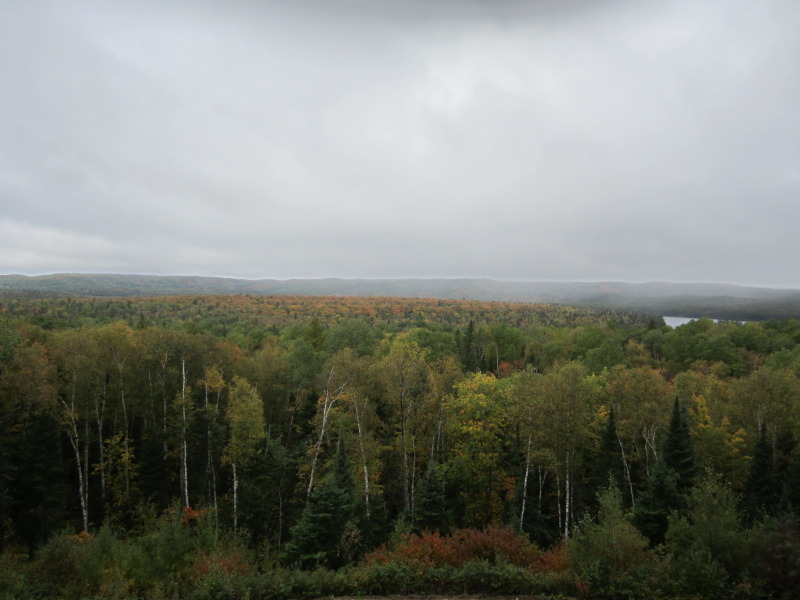
Foggy view of the Brent Crater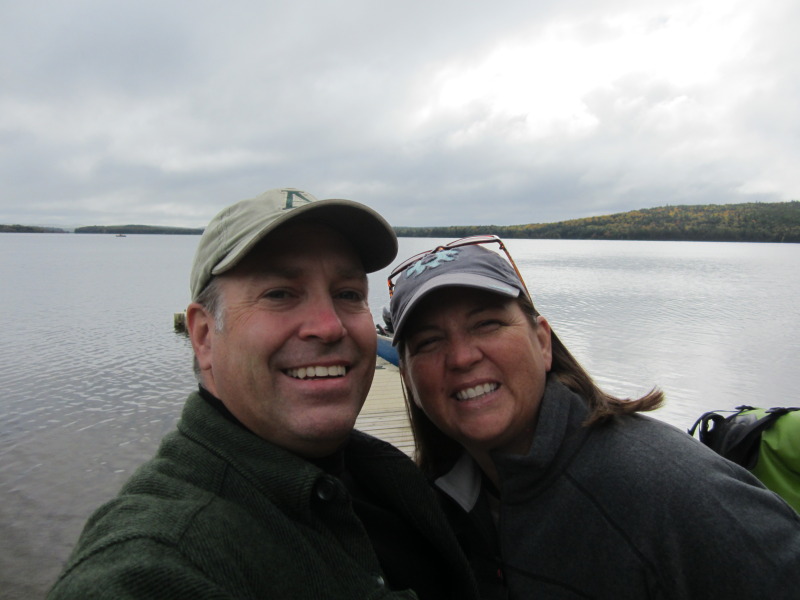
Excited to start!
Wind-whipped Cedar Lake.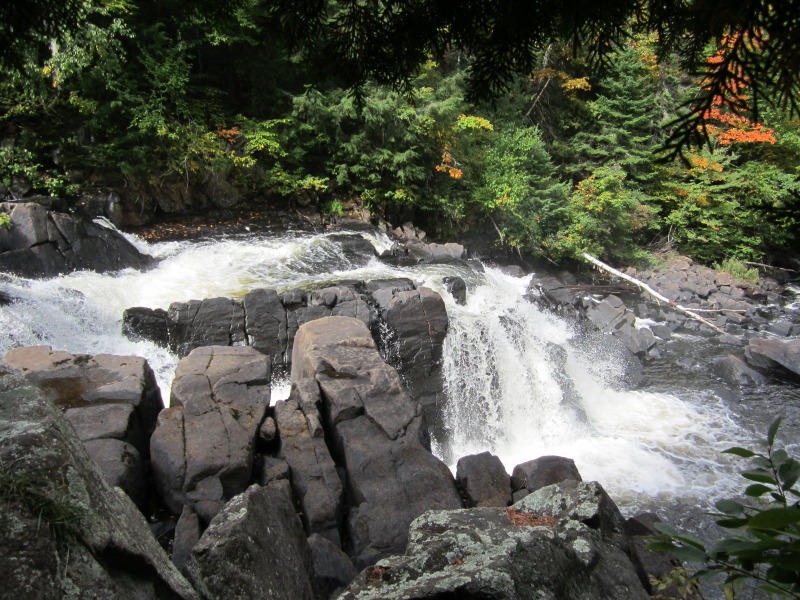
We stopped along the first portage to see the falls.
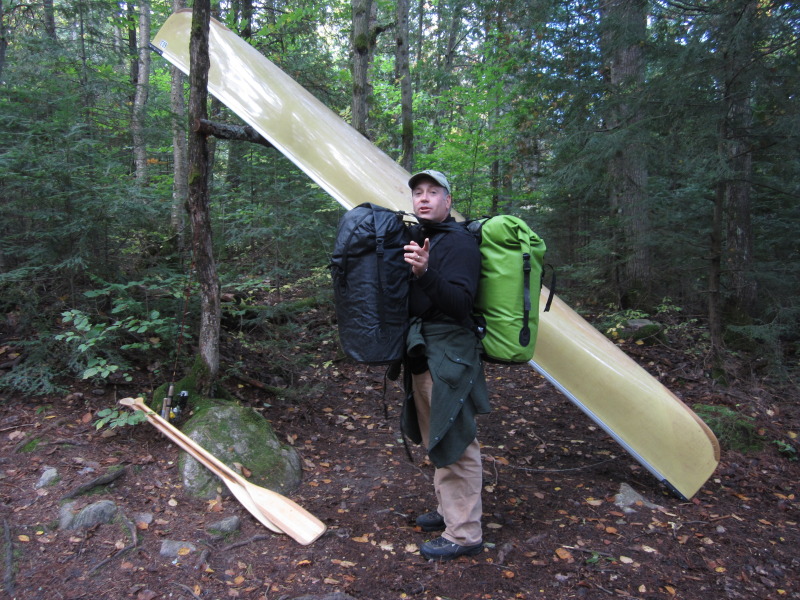
Packeus Muleus – a beast of burden known for brief stubborn stints while portaging.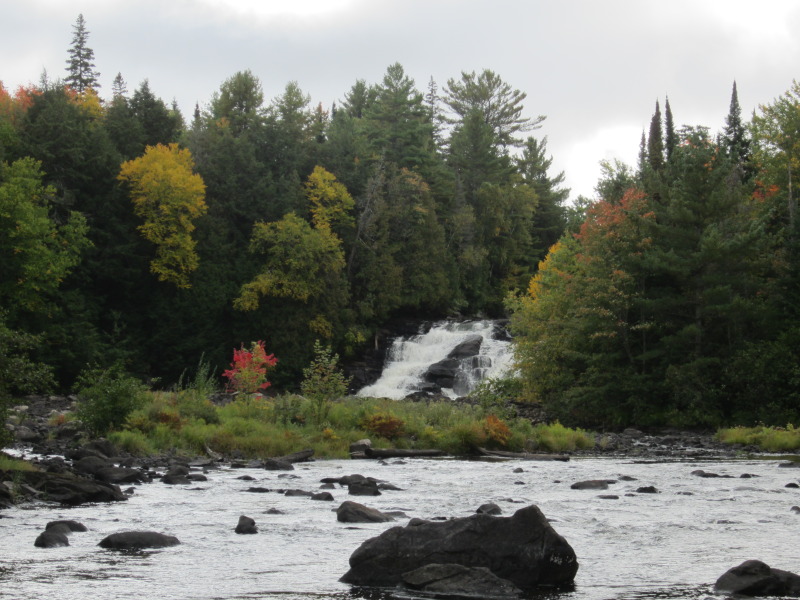
A splash of color next to a set of falls on the Petawawa.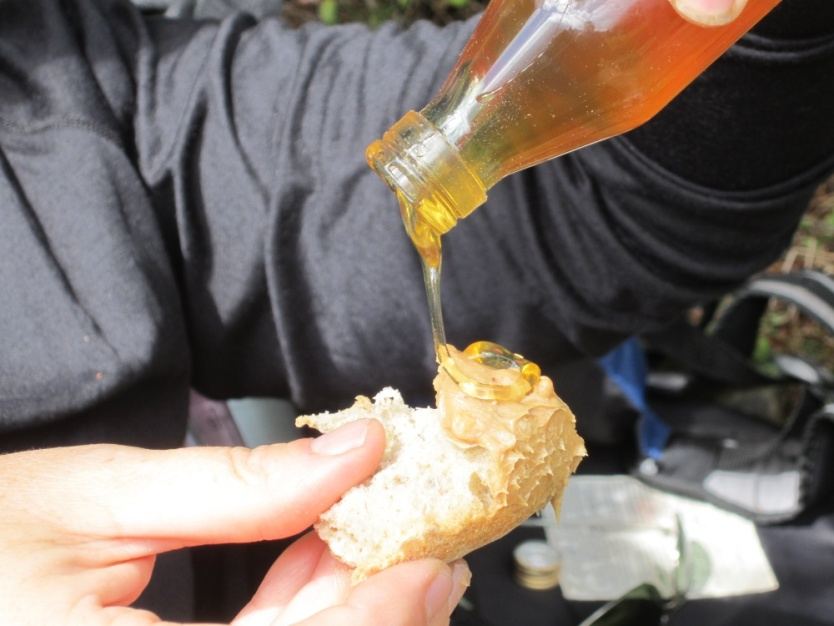
Crunchy peanut butter with Alfalfa Honey (try it, we prefer its flavor to clover or other varieties) on hard roll.
A full bag of garbage…wouldn’t have been as bad but they also left the fire ring full of trash.
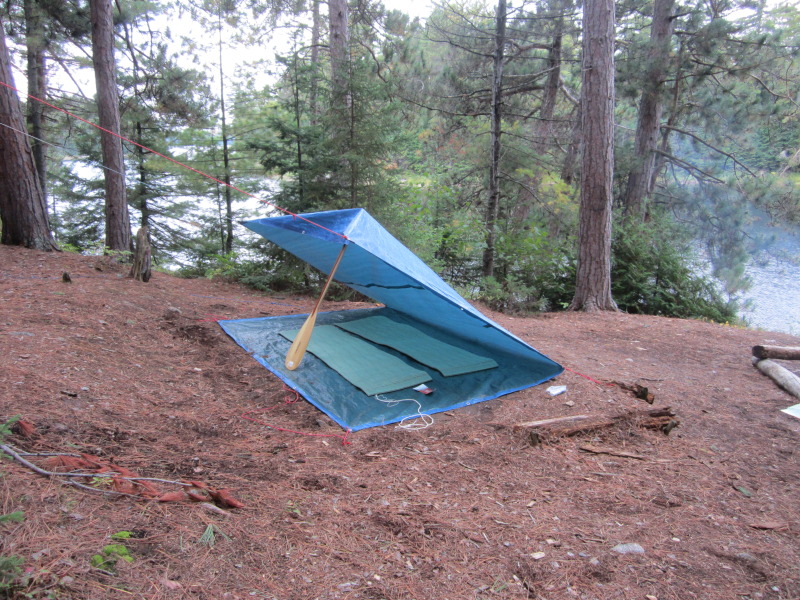
We set up a simple, cozy shelter for the evening and left the hammocks packed for another night.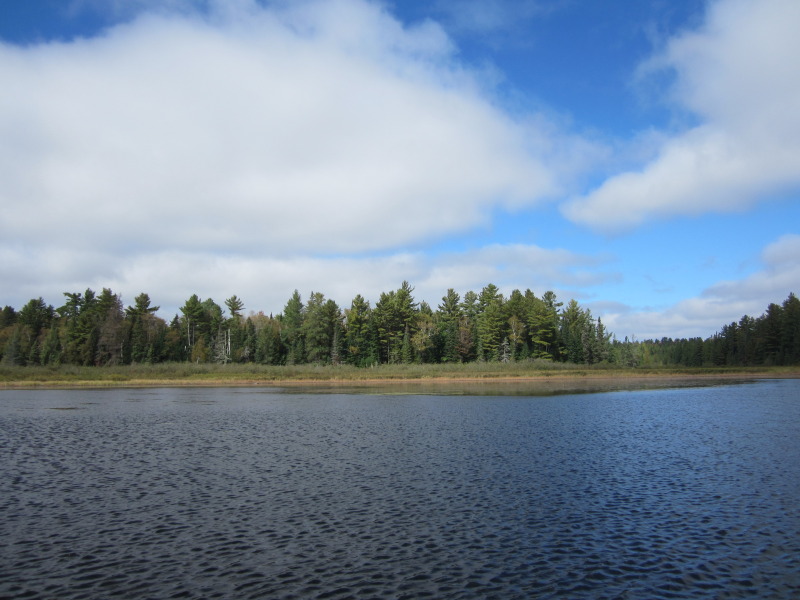
Sunshine breaking through the clouds along Perley Lake.
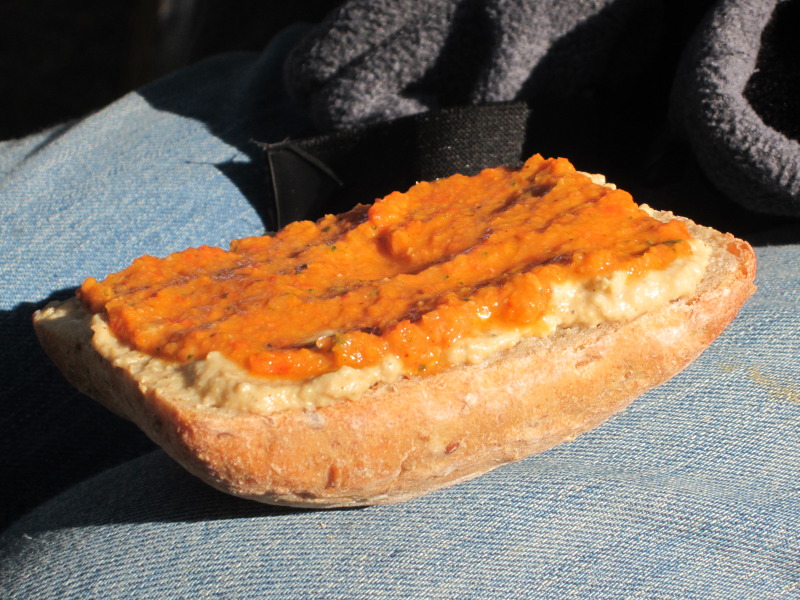
We stopped along Perley Lake for a lunch break of hummus and roasted tomato dip on sliced hard rolls.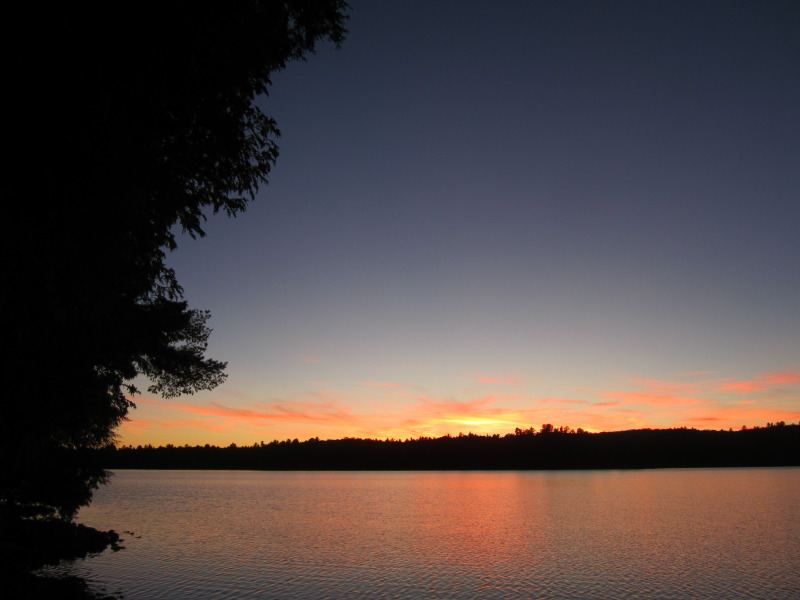
A serene sunset from one of the many islands on Burntroot Lake.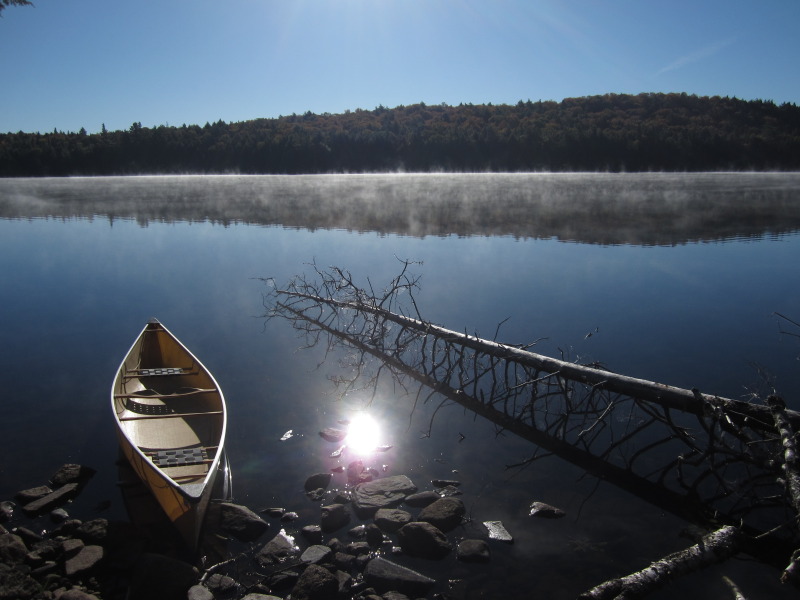
The morning dawned foggy but quickly burnt off by 8:30. This photo doesn’t do the scene justice compared to experiencing it!
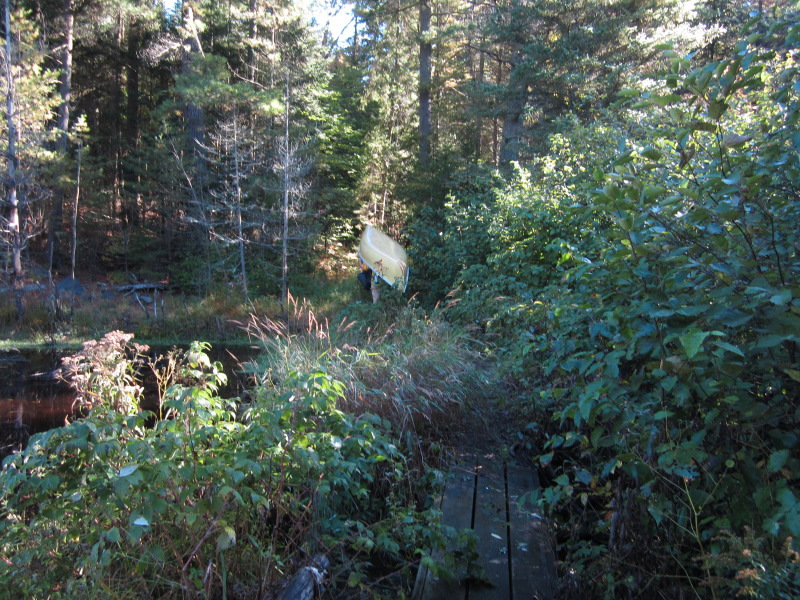
The portage to Robinson Lake had a couple small climbs and an easy crossing of a beaver dam.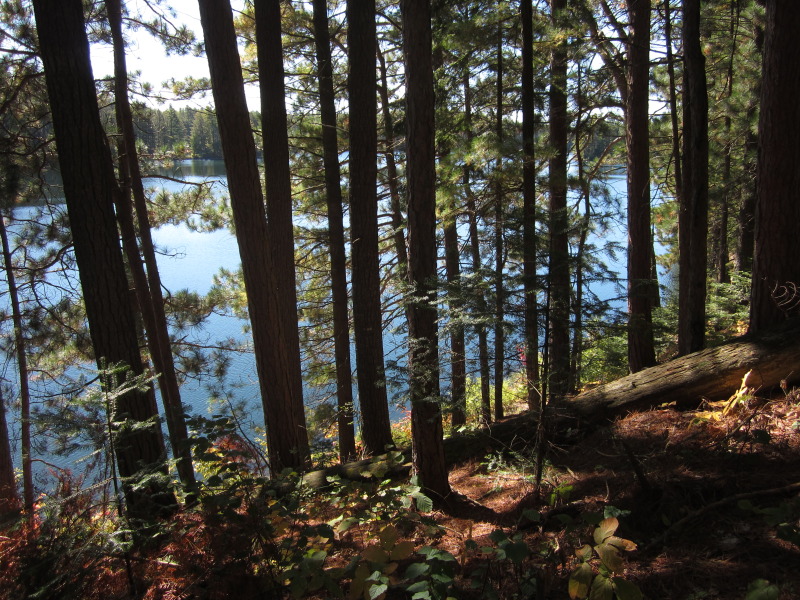
The ever-welcome sight near the end of a portage, when you see the crystal blue water sparkling through the forest.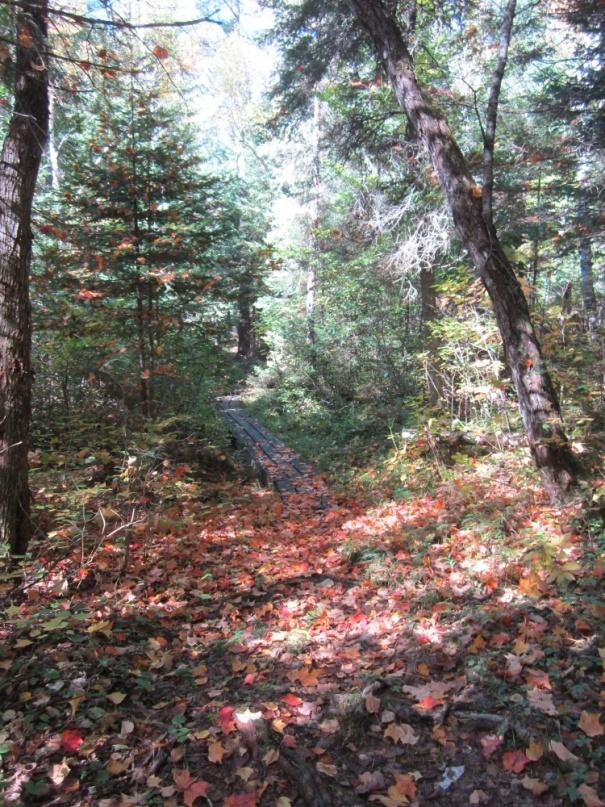
A carpet of pink draped over the portage.
I defy any bear or mammal to get at this food bag…they would have to be trained in trapeze!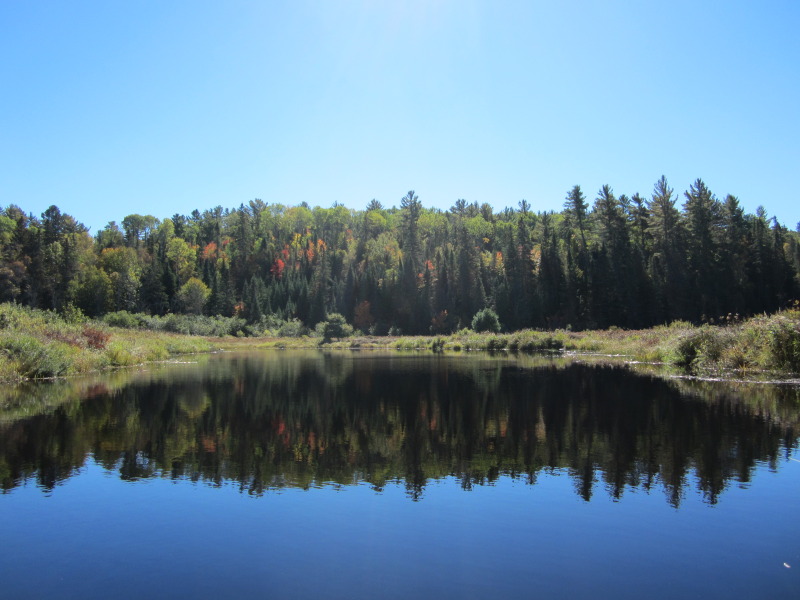
The views along the Nipissing River were breathtaking.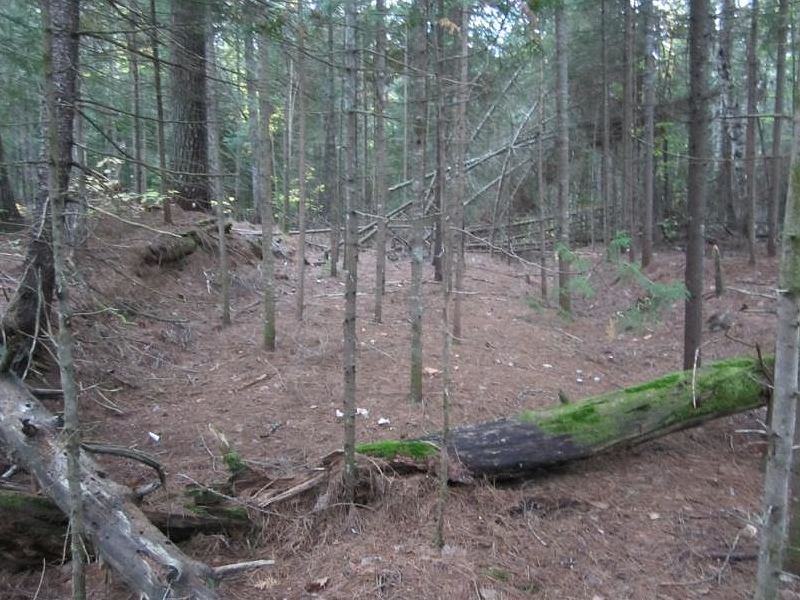
The old, overgrown roadbed.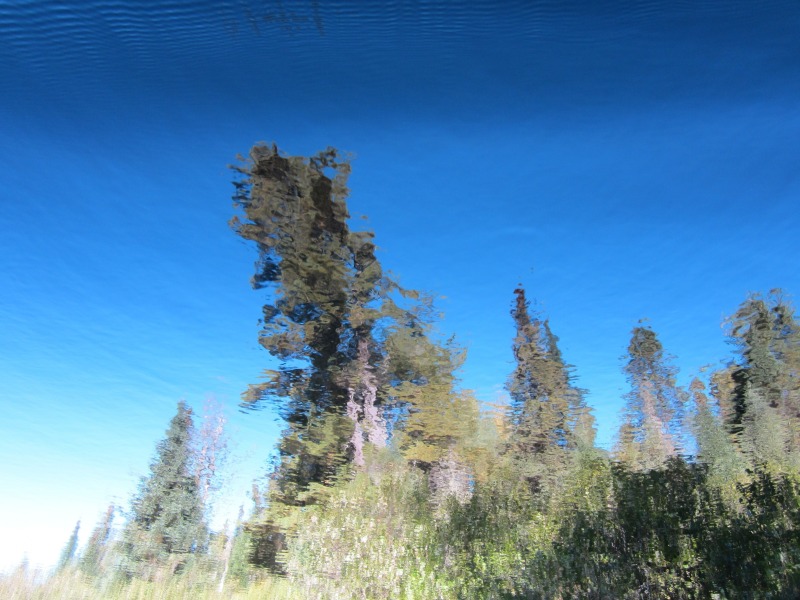
An “impressionistic” image of the shoreline of the Nipissing River.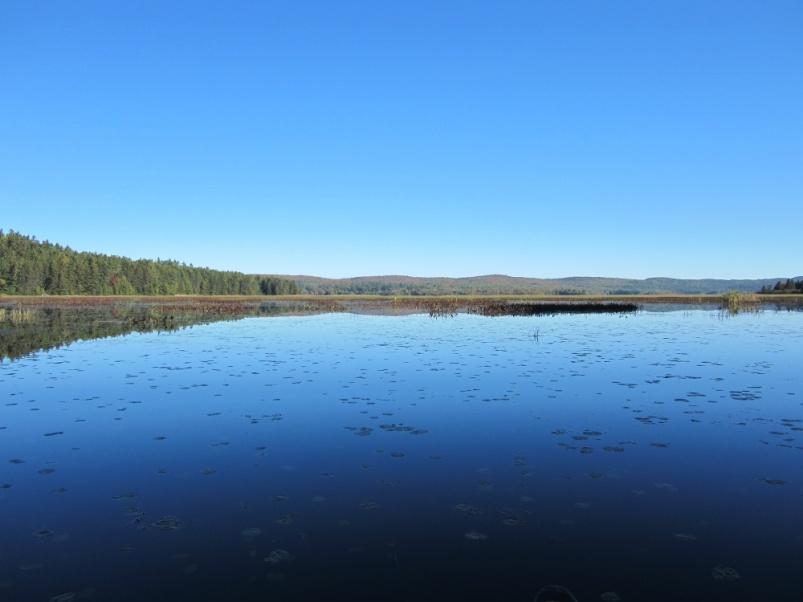
A serene Marshy Bay was the welcome mat to an equally smooth Cedar Lake.
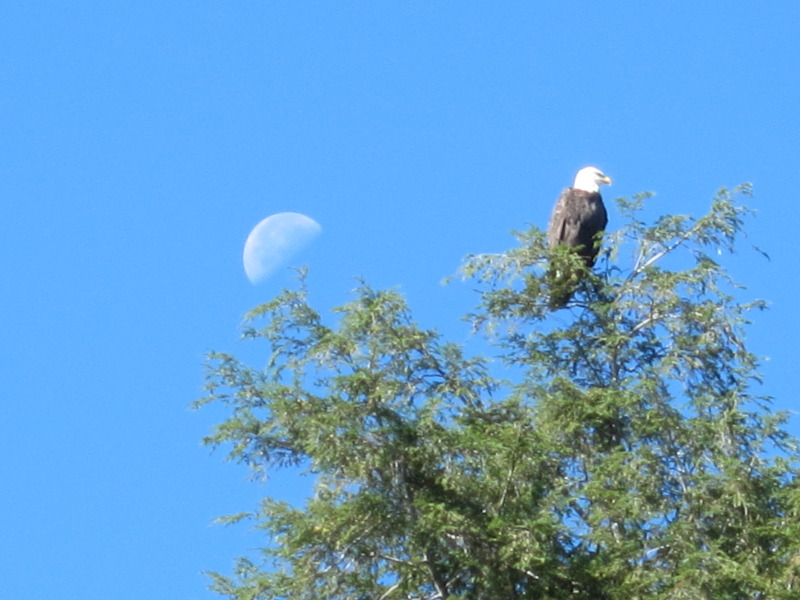
A smooth and simple crossing of the lake brought us under the watchful eye of this majestic bird as we approached the dock at Brent.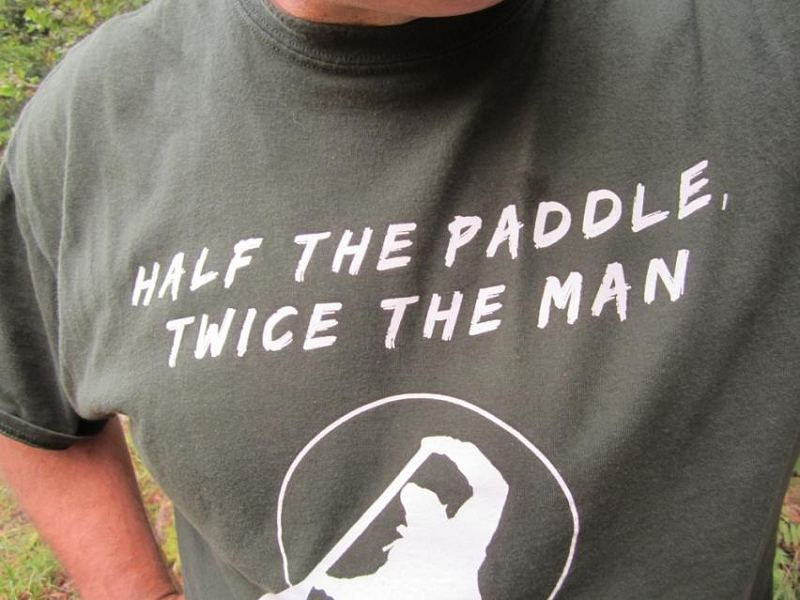
A closing, light-hearted dig from a canoe purist to kayakers …
Distance paddled: 39.8 miles, 64.1 kilometers
Distance portaged: 7.5 miles, 12.1 kilometers
Day 1: ~ 8.2 miles, 13.2 kilometers
Day 2: ~ 9.9 miles, 15.9 kilometers
Day 3: ~ 5.7 miles, 9.2 kilometers
Day 4: ~ 17.4 miles, 28 kilometers
Day 5: ~ 5.0 miles, 8 kilometers